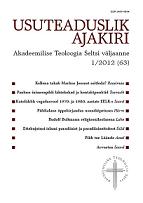Pauluse inimesepildi lähtekohad ja kontaktpunktid
Points of Departure and Contact in the Pauline View of Man
Author(s): Randar TasmuthSubject(s): Christian Theology and Religion
Published by: Akadeemiline Teoloogia Selts
Keywords: New Testament; Biblical Studies; Paul
Summary/Abstract: Randar Tasmuth, Points of Departure and Contact in the Pauline View of Man The aim of this article is to outline what kind of cultural and religious patterns – terminology and methods – influenced Paul’s thought world. Commonly known and shared ideas and conventions of thought in anthropology at the turn of the era are of particular interest. Probably Paul’s thought world could not be distinctively split into a Jewish half and a Greek half, though his upbringing consisted of both ways of thinking. Special attention is given to the word sōma because of its frequent use and theological weight in the epistles of Paul. In the history of research of the anthropology of Paul and the term sōma, Traugott Schmid sought to show that sōma Xristou was an interpretative category and of central importance to understand the meaning of the body in general. Rudolph Bultmann put human body in the forefront and interpreted the theology of Paul as anthropology. Bultmann „discovered“ the importance of sōma for Paul and put it into the centre of his anthropology. Man does not „have“ sōma but man „is“ sōma. Methodically anthropological terms should be studied in their use in conflict settings. The context of every letter may give a different flavour to the terms. As R. Jewett says, the approach will be to take account of the literary context of the sentence, the paragraph and the letter as a whole. The word sōma has been in practical use through centuries and has had a long literary history as well. For the Jews and Paul especially the LXX was the book where Hebrew terms were translated or such Greeks words introduced that did not have a Hebrew equivalent. Sōma was one of the most meaningful terms among these words. In the history of Greek literature, sōma most generally designated the body of an animal or man, dead or alive. The same applies to the LXX. In addition, sōma functions as a bearer of the identity of the living creature. The LXX as one of the sources of Paul’s terminology utilized sōma also to designate slaves. Nearly the same applies to the Apocryphal and other Deutero-canonical literature which leads us into the first Christian century. Paul clearly cannot be tied to Septuagintal meanings, since there were other influences on his vocabulary. But the observations suggest that though on the basis of the Septuagint we cannot definitely say that sōma means “person”, it is nevertheless often used for a person. For the future studies on the anthropology of Paul it is necessary to add that this understanding of sōma should have been common both for Paul and the recipients of his writings. Thus Paul was able to build part of the communication upon at least some ideas which he shared with his Greek speaking readers: Jewish, Greek and Roman.
Journal: Usuteaduslik Ajakiri
- Issue Year: 2012
- Issue No: 1 (62)
- Page Range: 16-35
- Page Count: 20
- Language: Estonian

